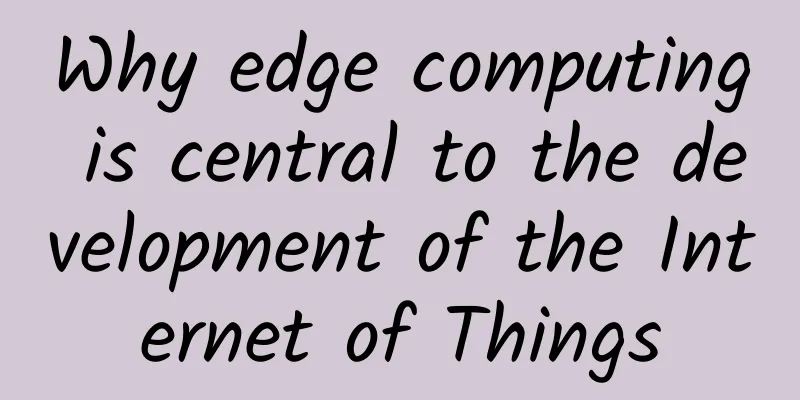Why edge computing is central to the development of the Internet of Things

|
Many connected devices today are able to take advantage of cloud computing, but IoT device manufacturers and application developers are discovering the benefits of performing computing and data analysis on the device itself. On-device computing and analysis can help reduce latency for critical applications, reduce reliance on the cloud, and better manage the large amounts of data generated by the Internet of Things. This on-device approach to data processing and analysis is known in the industry as edge computing, treating devices at the edge of the network/cloud as if they were Internet-connected devices and networks. Computing opens up new possibilities in IoT applications, especially for tasks that rely on machine learning, such as object detection, face recognition, language processing, and obstacle avoidance.
The rise of edge computing is a well-known technology iteration that started with centralized processing and then evolved into a distributed architecture. The Internet itself started with mainframes in government agencies and universities, then evolved into PCs and then into pages on the emerging Internet. The mobility revolution accelerated greatly when smartphones replaced feature phones at the edge of cellular networks. The impact of edge computing on the Internet of Things is similar, with the edge computing ecosystem growing rapidly as end devices become more powerful and capable of running more complex applications. Edge computing provides tangible value in both consumer and industrial IoT use cases. It can only help reduce connectivity costs by sending important information rather than raw sensor data streams, which is especially important for devices connected via LTE/cellular (such as smart meters or asset trackers). In addition, when dealing with big data generated by sensors in industrial facilities, the ability to analyze and filter data before sending it will greatly save network and computing resources. Edge computing helps improve security and privacy by keeping sensitive data on the device. Edge computing helps protect user privacy by anonymizing, analyzing, and retaining data sources instead of sending identifiable information to the cloud. Edge computing can also reduce latency and make connected applications more responsive and robust. The surge in machine learning for IoT applications is a strong driver for increasing edge computing capabilities. Not only do devices need to run complex deep learning networks quickly, but since many IoT devices are powered by batteries, this is needed to reduce energy consumption. This has promoted the emergence of heterogeneous computing architectures, integrating multiple engines such as CPUs, GPUs, and DSPs into IoT devices, thereby assigning different workloads to the most efficient computing engine, thereby improving performance and reducing energy consumption. In fact, when running the same workload on the CPU, the DSP uses 25 times less energy and improves performance by 8 times. With edge computing, system architects need to learn how to take advantage of available distributed computing capabilities from end to end, fully tapping the capabilities of field devices, gateways, and the cloud. Edge computing combined with advanced technologies such as 5G will provide faster, more powerful, and larger-scale connections, and a new generation of smart devices and applications will soon emerge. |
<<: Seven technology trends for 2018 that IT pros need to know
>>: The impact of blockchain on data centers and cloud computing
Recommend
U.S. Department of Commerce: Will allow U.S. companies to work with Huawei to develop 5G network standards
[[330263]] In the early morning of June 16th, Bei...
Network cabling management issues in data center transformation and upgrading
Cabling is an important part of the internal netw...
How can domestic Wi-Fi chips make up for the "lost decade"?
Since Wi-Fi 5 was launched in 2013, the gap betwe...
Understand RFID technology in one article! 3 types, 6 fields, 7 major advantages
Why can our express deliveries always be accurate...
Virtono saves 10 euros: Romania/UK/Dallas KVM annual payment starts from 4.95 euros
Virtono has launched a promotion where people can...
TNAHosting: $5/month-4 cores/12GB/500GB/15TB/Chicago data center
TNAHosting is a foreign hosting company founded i...
Are operators “breaking away from” the old ways? 2G/3G networks will eventually leave the stage
Recently, China Telecom Yunnan Company (Yunnan Te...
Is the WiFi slow and lag the router? The phone is to blame
Under the guidance of the idea of increasing mo...
From "Integration" to "Huawei Inside", Huawei builds a new ecosystem in the intelligent era
[51CTO.com original article] [Fuzhou, China, Marc...
The United States has another big move for 5G: agreeing to merge two major operators
[[265869]] The Trump administration has tried eve...
Does Localhost necessarily mean Localhost?
[[405743]] We often use the localhost domain name...
How 5G will change engineering design
The past decade has seen unprecedented technologi...
How did TA succeed in intercepting tens of millions of malicious addresses?
Want to self-check and improve your cybersecurity...
Unleashing the power of 5G: Innovative devices will revolutionize connectivity
There’s no denying that the advent of 5G technolo...
CNNIC releases the 49th "Statistical Report on Internet Development in China"
The China Internet Network Information Center (CN...






![[6.18] UFOVPS 20% off, top up 200 yuan and get 10 yuan, US CN2/Japan CN2 GIA/Hong Kong CN2 GIA optional](/upload/images/67cabe6b63f72.webp)


